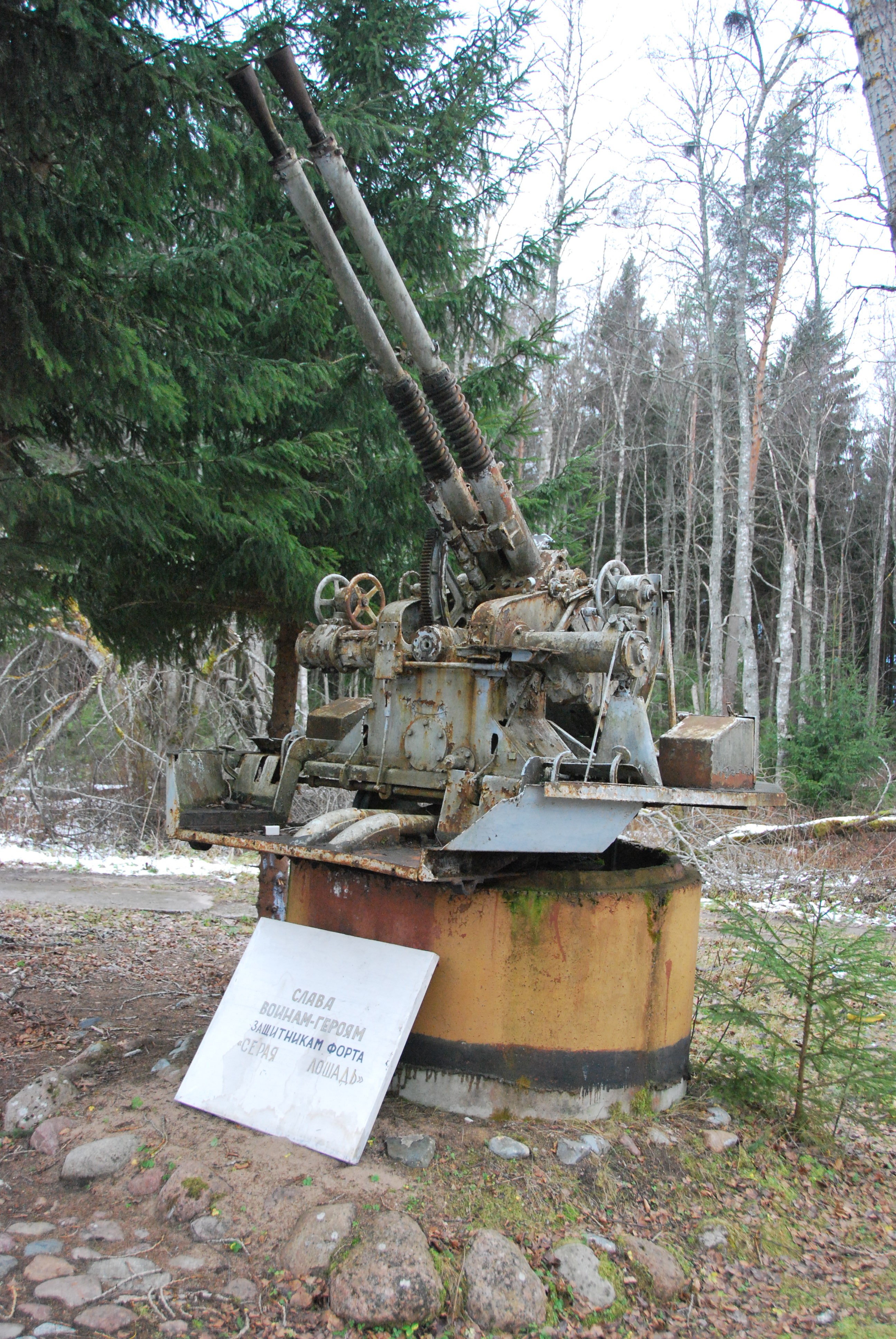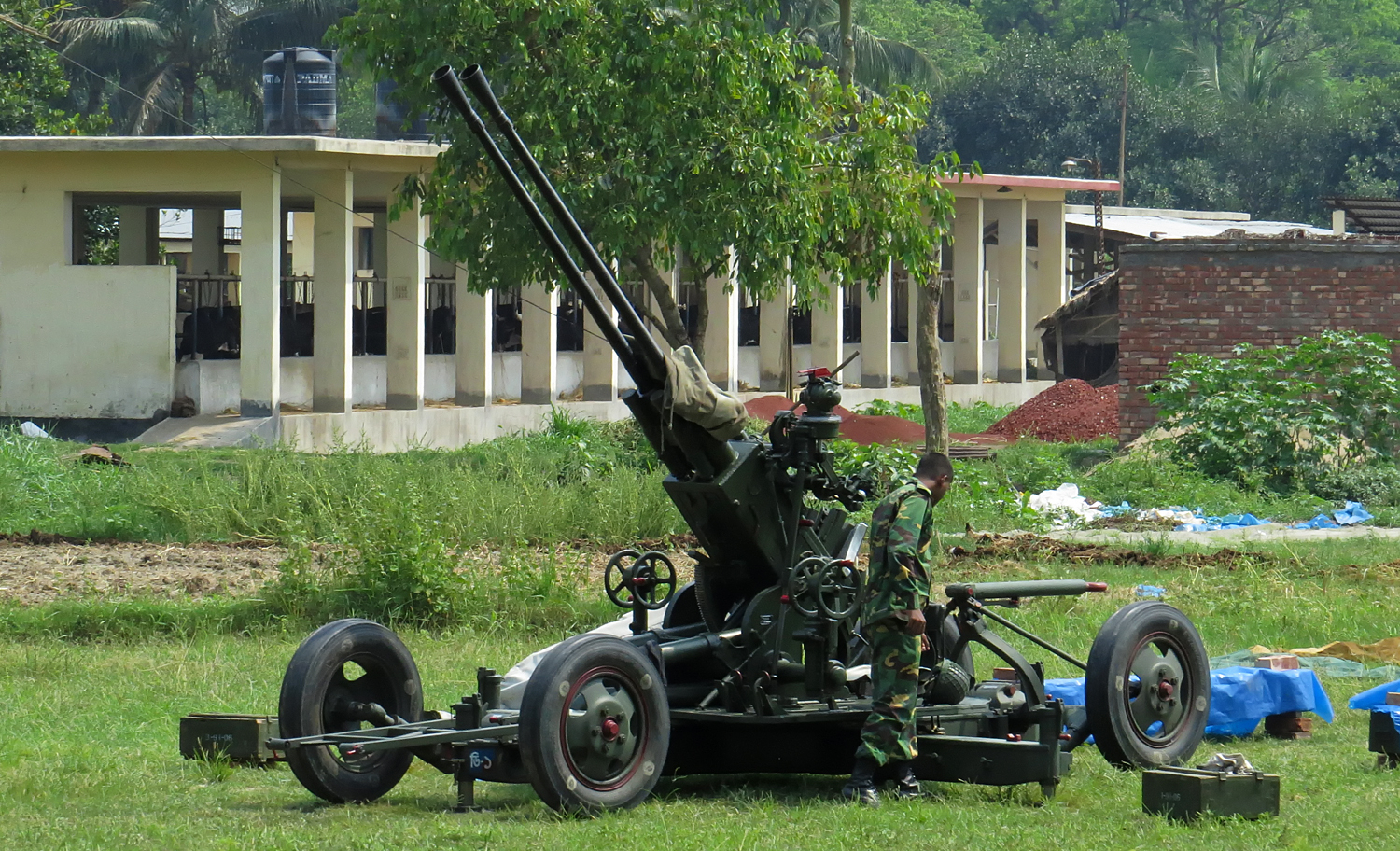37 mm automatic air defense gun M1939 (61-K) on:
[Wikipedia]
[Google]
[Amazon]
 The 37 mm automatic air defense gun M1939 (61-K) (russian: 37-мм автоматическая зенитная пушка образца 1939 года (61-К)) is a
The 37 mm automatic air defense gun M1939 (61-K) (russian: 37-мм автоматическая зенитная пушка образца 1939 года (61-К)) is a

 One drawback was that the 70K required a barrel change after every 100 rounds fired. To improve on this, a twin-barrel water cooled mount, the V-11 (called "W-11" in East Germany and Poland because of different Cyrillic transliteration), entered service in 1946, and was in production until 1957. A total of 1,872 V-11 mounts were built.
After this an 85- calibre
One drawback was that the 70K required a barrel change after every 100 rounds fired. To improve on this, a twin-barrel water cooled mount, the V-11 (called "W-11" in East Germany and Poland because of different Cyrillic transliteration), entered service in 1946, and was in production until 1957. A total of 1,872 V-11 mounts were built.
After this an 85- calibre
 ** Type 55 – copy of the single barreled 37 mm M1939
** Type 63 – twin 37 mm guns with vertical stabilization mounted on a T-34 chassis.
** Type 65 – copy of the twin barreled 37 mm.
** Type 74 – upgraded version of the Type 65 with a greater rate of fire.
** Type 74SD – Type 74 with servo system removed for operation with Type 800 laser course director system.
** Type 79-III – upgraded version of the Type 74 with electro-optical director, and powered traverse and elevation.
** Type 76 – Naval version of the twin 37 mm.
** P793 – Advanced twin-barrel version, with electro-optical predicting sight and higher rate of fire and lengthened barrels giving a higher muzzle velocity (1,000 m/s). Operated by a crew of 5 or 6.
* North Korea
** Self-propelled version
** Type 55 – copy of the single barreled 37 mm M1939
** Type 63 – twin 37 mm guns with vertical stabilization mounted on a T-34 chassis.
** Type 65 – copy of the twin barreled 37 mm.
** Type 74 – upgraded version of the Type 65 with a greater rate of fire.
** Type 74SD – Type 74 with servo system removed for operation with Type 800 laser course director system.
** Type 79-III – upgraded version of the Type 74 with electro-optical director, and powered traverse and elevation.
** Type 76 – Naval version of the twin 37 mm.
** P793 – Advanced twin-barrel version, with electro-optical predicting sight and higher rate of fire and lengthened barrels giving a higher muzzle velocity (1,000 m/s). Operated by a crew of 5 or 6.
* North Korea
** Self-propelled version

 The 37 mm automatic air defense gun M1939 (61-K) (russian: 37-мм автоматическая зенитная пушка образца 1939 года (61-К)) is a
The 37 mm automatic air defense gun M1939 (61-K) (russian: 37-мм автоматическая зенитная пушка образца 1939 года (61-К)) is a Soviet
The Soviet Union,. officially the Union of Soviet Socialist Republics. (USSR),. was a List of former transcontinental countries#Since 1700, transcontinental country that spanned much of Eurasia from 1922 to 1991. A flagship communist state, ...
37 mm calibre anti-aircraft gun
Anti-aircraft warfare, counter-air or air defence forces is the battlespace response to aerial warfare, defined by NATO as "all measures designed to nullify or reduce the effectiveness of hostile air action".AAP-6 It includes surface based ...
developed during the late 1930s and used during World War II
World War II or the Second World War, often abbreviated as WWII or WW2, was a world war that lasted from 1939 to 1945. It involved the World War II by country, vast majority of the world's countries—including all of the great power ...
. The land-based version was replaced in Soviet service by the AZP S-60
AZP S-60 (russian: Автоматическая зенитная пушка С-60, abbrev. АЗП (AZP); literally: ''Automatic anti-aircraft gun S-60'') is a Soviet towed, road-transportable, short- to medium-range, single-barrel anti-aircraft ...
during the 1950s. Guns of this type were successfully used throughout the Eastern Front against dive bombers and other low- and medium-altitude targets. It also had some usefulness against lightly armoured ground targets.
Development
The Soviet Navy purchased a number ofBofors
AB Bofors ( , , ) is a former Swedish arms manufacturer which today is part of the British arms concern BAE Systems. The name has been associated with the iron industry and artillery manufacturing for more than 350 years.
History
Located ...
25 mm Model 1933 guns in 1935, trials of the weapon were successful and it was decided to develop a 45 mm version of the weapon designated the 49-K. The development under the guidance of leading Soviet designers M. N. Loginov, I. A. Lyamin and L. V. Lyuliev was successful, but the army thought that the 45 mm calibre was a little too large for an automatic field weapon. In January 1938 the Artillery Factory Number 8 in Sverdlovsk was ordered to develop a 37 mm weapon based on the same design. The task was fulfilled by the chief designer of the factory, Mikhail Loginov, and his assistant Lev Loktev. Firing trials of the new 61-K were conducted in October 1938.
Competitive firing trials were conducted in 1940 between the 61-K and the Bofors 40 mm/56. There were no substantial differences found between them.

Land version
The weapon was initially installed as a single-barrel weapon on a four-wheeled ZU-7 carriage, and was soon ready for service. An initial order for 900 units was placed. The gun was operated by a crew of eight men. A total of 200 rounds of ammunition were carried which were fed into the gun in five-round clips. Total Soviet production was around 20,000 units, ending in 1945. However, it has also been produced in Poland, China and North Korea. Armour penetration of the armour-piercing (AP) rounds is reported as 37 millimetres ofrolled homogeneous armour
Rolled homogeneous armour (RHA) is a type of vehicle armour made of a single steel composition hot-rolled to improve its material characteristics, as opposed to layered or cemented armour. Its first common application was in tanks. After World ...
(RHA) at 60°at 500 metres range and 28 millimetres of RHA at 90° at 1,500 metres range.
Naval version
The naval mounting was produced as the 70K, and had entered service before the German invasion of the Soviet Union replacing the semi-automatic 45 mm/46 21-K on many ships. It was fitted in large numbers to Soviet ships during the Second World War, including the T301 class minesweeper. The V70K was produced until 1955, with a total of 3,113 built.anti-aircraft
Anti-aircraft warfare, counter-air or air defence forces is the battlespace response to aerial warfare, defined by NATO as "all measures designed to nullify or reduce the effectiveness of hostile air action".AAP-6 It includes surface based ...
mounts long version, the 45 mm/85, was developed and accepted into service in 1954, it was deployed in twin and quad turrets on a number of classes of vessels, including the '' Neustrashimyy'', '' Kildin'' and ''Kotlin'' class destroyer
In naval terminology, a destroyer is a fast, manoeuvrable, long-endurance warship intended to escort
larger vessels in a fleet, convoy or battle group and defend them against powerful short range attackers. They were originally developed ...
s. However it was later replaced with the ZIF-31 twin 57 mm mounting.
The 37 mm twin mounting was exported to China where it was manufactured and used extensively, as the "Type 65". A turret based version was produced from the late 1980s called the "Type 76" or H/PJA 76.
ZSU-37
TheZSU-37
ZSU-37 was a Soviet-made, light, self-propelled anti-aircraft gun (SPAAG), developed by the end of 1943 and produced at Works No. 40 in Mytishchi. It was the first Soviet series-produced tracked SPAAG. ZSU stands for Zenitnaya Samokhodnaya Usta ...
was developed late in the Second World War, it was a single 37 mm gun mounted in a large open turret on the chassis of the SU-76 self-propelled gun .
Specifications
* Recoil length: 150 to 175 mmAmmunition
The cannon fires 37×252SR shells. The shells use brass cases lined with waxed paper and use KV-2U percussion primers. A small piece of lead-tin wire is included in the case to act as a de-coppering agent, to counteract the buildup of copper from the driving bands of the projectiles. The Ammunition is produced in a number of countries including China, Russia, Egypt, Pakistan and Yugoslavia. The projectiles themselves are identical to those fired by the NS-37 aircraft cannon. The explosive shells are fitted with point detonating fuzes making them unsuitable for engaging fast moving or small targets.Variants
*Norinco
China North Industries Group Corporation Limited, doing business internationally as Norinco Group (North Industries Corporation), and known within China as China Ordnance Industries Group Corporation Limited (), is a Chinese state-owned defense ...
(Chinese)
 ** Type 55 – copy of the single barreled 37 mm M1939
** Type 63 – twin 37 mm guns with vertical stabilization mounted on a T-34 chassis.
** Type 65 – copy of the twin barreled 37 mm.
** Type 74 – upgraded version of the Type 65 with a greater rate of fire.
** Type 74SD – Type 74 with servo system removed for operation with Type 800 laser course director system.
** Type 79-III – upgraded version of the Type 74 with electro-optical director, and powered traverse and elevation.
** Type 76 – Naval version of the twin 37 mm.
** P793 – Advanced twin-barrel version, with electro-optical predicting sight and higher rate of fire and lengthened barrels giving a higher muzzle velocity (1,000 m/s). Operated by a crew of 5 or 6.
* North Korea
** Self-propelled version
** Type 55 – copy of the single barreled 37 mm M1939
** Type 63 – twin 37 mm guns with vertical stabilization mounted on a T-34 chassis.
** Type 65 – copy of the twin barreled 37 mm.
** Type 74 – upgraded version of the Type 65 with a greater rate of fire.
** Type 74SD – Type 74 with servo system removed for operation with Type 800 laser course director system.
** Type 79-III – upgraded version of the Type 74 with electro-optical director, and powered traverse and elevation.
** Type 76 – Naval version of the twin 37 mm.
** P793 – Advanced twin-barrel version, with electro-optical predicting sight and higher rate of fire and lengthened barrels giving a higher muzzle velocity (1,000 m/s). Operated by a crew of 5 or 6.
* North Korea
** Self-propelled version
Comparison of anti-aircraft guns
Users
Current operators

Former operators
See also
*Weapons of the Laotian Civil War
The Laotian Civil War was a military conflict that pitted the guerrilla forces of the Marxist-oriented Pathet Lao against the armed and security forces of the Kingdom of Laos ( French: ''Royaume du Laos''), led by the conservative Royal Lao Gove ...
*Weapons of the Lebanese Civil War
The Lebanese Civil War was a multi-sided military conflict that pitted a variety of local irregular militias, both Muslim and Christian, against each other between 1975 and 1990.
A wide variety of weapons were used by the different armies and ...
Notes
References
* * * Janes, ''Ammunition Handbook 2003–2004'' * Janes, ''Land Based Air Defense 2005–2006'' * Shunkov V. N. – ''The Weapons of the Red Army'', Mn. Harvest, 1999 (Шунков В. Н. – ''Оружие Красной Армии.'' — Мн.: Харвест, 1999.) * {{DEFAULTSORT:37 Mm Automatic Air Defense Gun M1939 (61-K) 37 mm artillery Anti-aircraft guns of the Soviet Union World War II anti-aircraft guns World War II artillery of the Soviet Union Military equipment introduced in the 1930s